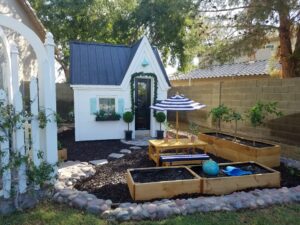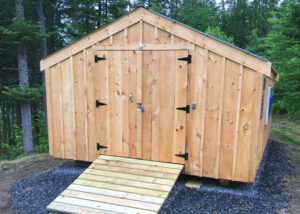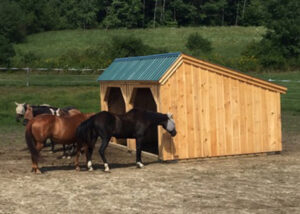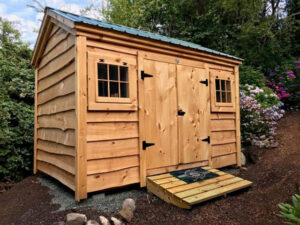Whether you want to go fully solar in order to reduce your carbon footprint or you are attracted to solar energy as a way to gain off-grid independence, there is a lot to consider when adding solar power to your tiny home. Figuring out exactly how much energy you will need can be daunting. Your energy needs depend on your typical power use and how many appliances you plan on running. There are limiting factors that can affect your decisions around adding solar. Taking all this into consideration seems like a lot, but we’re here to break down the basics for you.
Let’s dive right in to learning about how to determine your tiny house energy needs, and how to settle on a solar power system that is right for your lifestyle.
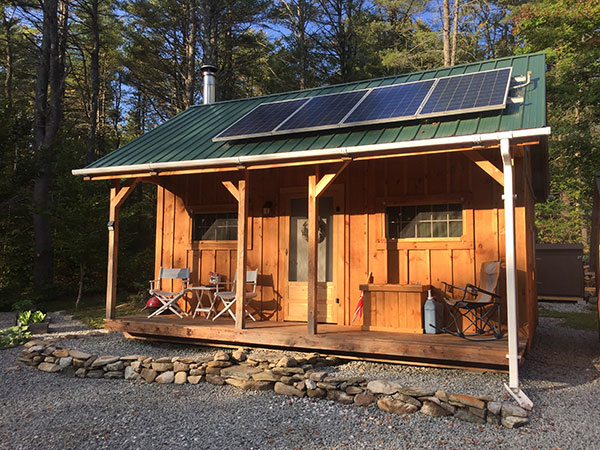
How much energy does my tiny house need?
If you’re already living in a tiny home that is on the energy grid, you can easily determine how much energy you’ll need to supply if you want to switch to solar. Just look at your utility bills! Try to figure out how many Watt-hours you use per day. When calculating this, be careful not to use only one month as your reference. Look at your usage across the whole year, and find the months where you are using the most energy. If you live in a cooler climate, chances are this will be in the winter, and for those that use AC in warmer climates, this will be in the summer. Use these highs to estimate at a maximum how much energy you need.
Many sources suggest that tiny homes use between 900 and 1000 kiloWatt hours per year, or about 2.4 to 2.7 kiloWatt hours per day. However, you can get a more accurate estimate of the energy needs of your tiny home. Your energy use is determined by your home’s heat source, and the types of appliances you intend to use. Read more on how to calculate the energy needs for your tiny home!
Calculating tiny house solar power energy needs
If you aren’t yet living in your tiny home, but you know which appliances you will use, you can estimate your energy needs by calculating how much you plan on using each appliance every day. Here’s how you can estimate your appliance usage by calculating the Watt-hours for a mini refrigerator:
Find the Power Consumption:
Check the label or manual of your appliance for its power consumption. This is usually measured in Watts (W) and is sometimes labeled as “Rated Power” or “Power Consumption.” Let’s say your refrigerator’s power consumption is 50 watts.
Determine Operating Hours:
Estimate or measure how many hours your refrigerator runs in a day. This will vary based on factors such as the refrigerator’s efficiency, ambient temperature, and how often the door is opened. However, it’s best to assume that it will be running 24 hours a day.
Calculate Watt-Hours:
Multiply the power consumption (in watts) by the operating hours. This will give you the energy used by the refrigerator in Watt-hours. Using the previous example:
Watt-hours = Power Consumption (W) × Operating Hours (h)
Watt-hours = 50 W × 24 h = 1200 Wh per day
You can easily convert Watt hours into kiloWatt hours by dividing by 1000. This would make this refrigerator’s kWh 1.2 (1200 Wh / 1000 = 1.2 kWh)
If you make this calculation for all the appliances including lightbulbs that you intend to use, you can get a decent estimate of how much energy you are going to use daily. If you are still in the phase of picking out appliances for your tiny home, consider choosing smaller sized units, or appliances specifically designed to be efficient. This calculator can help you with your estimates of how much power your appliances will use.
Solar Panels for Tiny Homes
Now that you’ve got an idea of how much electricity your tiny home will need, you can get to work deciding on what solar panels to buy. If you are planning on going fully solar, but want to use your appliances during hours when the sun isn’t shining, you’ll also need to invest in a battery to store the solar energy you collect.
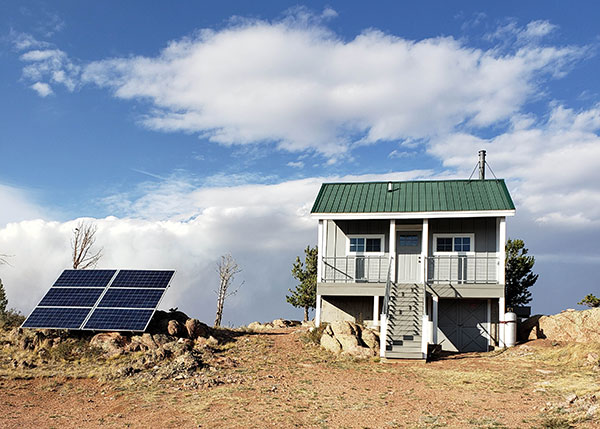
Wattage of Solar Panels:
Solar panels vary both in size and in the amount of electricity they are able to generate. There are two main sizes of solar panels: 60-cell panels and 72-cell panels. 60-cell panels are typically about 5.4 feet long by 3.25 feet wide, and have an output of 270 to 300 Watts, and are typically used for residential buildings. The 72-Cell panels have extra rows of cells, bringing them to 6.5 feet long by 3.25 feet wide. These can produce between 350 to 400 watts of power, and are mostly used commercially.
When choosing which solar panels are right for your tiny home, you will need to consider not only your energy needs, but where you will put the panels. If mounting them to your roof, make sure you are choosing a size that will fit properly, and that the panels will be positioned in a way that will allow them to get as much sun as possible throughout the day.
The watts a solar panel can yield are calculated under ideal conditions: this means that a 300 watt panel produces that much energy in an hour when it is exposed to full, direct sun. So that 300 watt panel will give you about 1,050 Watts of power over the course of 3.5 hours of peak sunlight.
How Much Sunlight Do You Get?
Different regions of the US get different amounts of peak sunlight hours. If you live in the Southwest, your solar panels will be able to absorb a maximum of energy for a longer period of time than if you live in the Northeast. Because of this, tiny homes in regions with less sun may need more solar panels to cover their energy needs. You can use this calculator to find out how many peak sun hours you get where you live.
How many solar panels does a tiny house need?
As you know by now, the number of solar panels your tiny house will need is determined by your energy use, the solar panel output, and the amount of sunlight you get in your region. Because energy needs fluctuate, you will want to slightly overshoot your production of solar energy compared to your energy usage. You can do this by calculating a production ratio, which is your solar energy system’s output, divided by your actual needs. Shoot for a production ratio target of 1.3 – 1.6.
Let’s do an example calculation to figure out how many solar panels you will need!
Let’s say you need an average of 3 kWh per day to power your tiny home, and you want to aim for a production ratio of 1.4. Multiply 3 kWh by 1.4 gives you a target of 4.2 kWh as the ideal amount of electricity you’ll want to produce in a day.
Now let’s consider the solar panels. The average wattage of a solar panel is 320 Watts. If you have 3.5 hours of peak sun per day, your solar panel can generate 1.12 kWh per day. Divide your target kWh (4.2) by the expected number of watt hours (1.12), and you get your number of solar panels:
4.2 kWh target / 1.12 kWh per day = 3.75 solar panels needed
Since you can’t have only .75 of a solar panel, round up! That means that for a tiny house that consumes about 3 kWh per day, you will want to install a total of four 320 Watt solar panels!
Storing Energy With Solar Batteries
Many people use solar energy as a way to supplement the energy needs of an on-the-grid house, but to go full solar, you need a battery. Your battery is what will keep you powered through cloudy days and long nights. A fully off-grid solar electric system consists of 4 components:
Solar Panels: The part of solar power we all know and love, these are the panels that absorb sunlight and generate electricity.
Charge Controller: This regulates how much power goes to charge your solar battery, and how much is sent directly to your inverter. This component is necessary for off-grid systems that use batteries.
Solar Battery: Your way of storing electricity for on-demand use
Inverter: This converts DC power to AC power that can be used by your appliances. For totally off-grid systems, you will need a hybrid inverter.
Choosing these components is just as important as choosing your solar panels, and will represent a significant portion of the costs of your tiny house solar project.
There are a number of types of batteries to choose from, each with benefits and drawbacks. Some batteries are more expensive, but last longer. Others are highly affordable and easy to dispose of, but have shorter life spans. Some are powerful but heavy, others are lightweight. For a first step into learning about the different kinds of solar batteries, we recommend this informative article.
Solar Panels on Cloudy Days
Unfortunately, we don’t live in a world where it’s sunshine all the time. The output of your solar system is dramatically impacted by cloud coverage. On an overcast day, your solar panels will yield only 10% – 25% of their yield under optimal conditions.
So that 300 Watt panel that can produce 1.12 kWh per day? That could go down to as little as 0.112 kWh per hour if you’ve got a cloudy day.
If you are planning to have your tiny home on-grid, this won’t be an issue. It just means that on overcast days, you’ll be drawing your energy from traditional electric sources. If you are fully off-grid however, you’ll need contingency plans. It may be a good idea to purchase extra solar panels if you frequently experience cloudy weather. Having a solar battery is very important in offsetting infrequent cloudy days. Finally, consider having another source of energy available to you in case of emergencies. Keeping a generator as back-up can be helpful if you go through an extended period of weather that is too cloudy to effectively power your home and charge your solar battery.
Where to install solar panels for your tiny home
How and where you install your panels will determine how effective they are at collecting the energy of the sun. Here are the two main ways people choose to install their solar panels
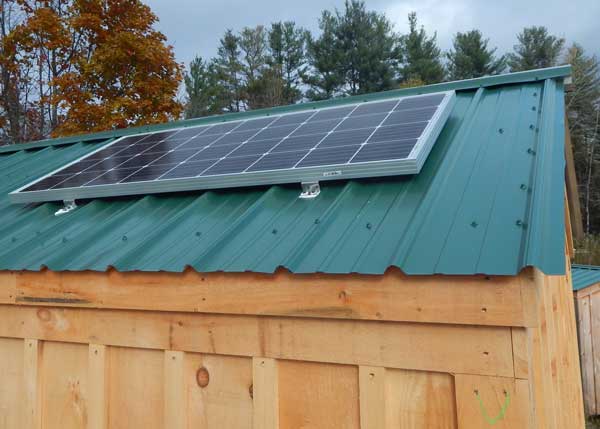
On the Roof: Many people in tiny homes opt to install their panels on the roofs of their houses. The benefits to this are that if your tiny home is mobile, your panels easily go wherever you go. By installing on your roof, you don’t have to take up space on your property, and mounting your panels high reduces some opportunities for them to be damaged. The drawbacks to roof installation are that sometimes the roof of your tiny home will not be oriented in the optimal direction and angle for collecting the most sun, reducing their efficiency.
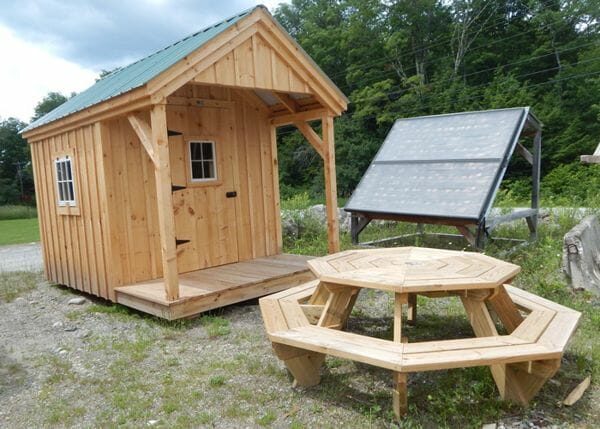
On the Ground: The other main option for installing solar panels is to set them up on the ground. This is a good option for people who do not live mobile lifestyles, and have enough space that using some of their land as a solar farm is not an issue. The benefit of placing solar panels on the ground is that you have more room for them, and you can optimally orient them to pick up as much sun as possible. One downside is that on the ground they can potentially be damaged by wild animals.
Ways to Reduce Electricity Needs For Solar Power
If you’ve done the math on solar energy and think it might not be able to cover all your electricity needs, there are ways you can cut down on your electricity usage to make solar a more viable option. Many people who live in tiny homes, vans, and off-grid opt for non-electric solutions for their most energy-intensive activities. Heating and cooking both require lots of energy, and there are alternatives available. Many people use small propane stoves for cooking their meals, which generates significant energy savings. Using a high efficiency wood burning stove as your primary heat source is also a great way to reduce reliance on electricity. Finally, there are manually-operated miniature washing machines that effectively clean your clothes, and typically subject your garments to less wear and tear than normal washing machines: it’s a win-win for reducing electricity use and keeping your clothes in top condition.
How to Purchase a Solar Energy System for your Tiny Home
If you are not an experienced solar installer or professional electrician, we don’t recommend installing solar as a DIY project. If you’re fully off-grid, your life and livelihood will depend on your solar energy working safely and reliably for you! Working with professionals can also help you navigate the ins and outs of solar energy that you might not be aware of. Some places require permits for solar installation, which professionals can help with. They can also help keep you aware of local tax incentives that will help you save money. Do the up-front research on your solar needs, and begin looking up solar installation technicians in your area.
Many solar installers start with systems that can yield up to 3 kW per hour (which in 3.5 hours of peak sun, will yield 10.5 kiloWatts in total), which is more than enough to power a tiny home with modest energy needs. This kind of system will typically have around 8-10 solar panels, which may be a lot for your tiny home. For some people, having a bigger system than necessary is a benefit, because if they are on-grid, they can sell the excess electricity produced. But if you need a tiny solar electric system, seek out tiny house specialists in your area. A smaller system of around 4 solar panels can be enough for your tiny home, and will save you money!

In Conclusion
Transitioning to solar power for your tiny home or off-grid cottage isn’t for everyone, but it might be the perfect option for you! Once you’ve considered your region, your electricity needs, and your budget, you can make an informed choice of how to power your homestead. We hope this guide has helped demystify some of the questions around whether solar is a good option for you. Good luck and happy homesteading!


